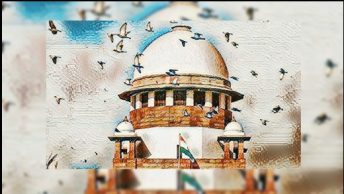(As part of our blog round-table book discussion, this is the second of the substantive responses to Julia Stephen’s Governing Islam: Law, Empire and Secularism in South Asia, by Professor Jeffrey Redding.)
Two images from “Governing Islam: Law, Empire, and Secularism in South Asia” (Cambridge University Press, 2018) are likely to stay with every reader of this ambitious, meticulous, and provocative new book by Julia Stephens. The first is from 1995, and is provided by a journalist’s photograph of veiled Muslim women in the streets of Delhi, holding market scales in their hands, marching and lamenting the third anniversary of the demolition of the Babri Masjid in Ayodhya by Hindu nationalists. The second image is that of a 2.5 ton steel statue in Bangladesh of Lady Justice, again holding scales—albeit of justice—while also porting a blindfold and enveloping sari. This statue was erected in a public square in Dhaka in 2017. However, in response to protests over its alleged impropriety, Lady Justice was eventually shifted into a more secluded compound of the Bangladeshi Supreme Court.
These two images—contained, respectively, in the book’s introduction and conclusion—bookend six chapters of critical historical analysis of the legal operationalization of secularism in colonial South Asia, with a special focus on secularism’s maneuvering with and against different strands of Muslim legal and political activism, and especially that engaged in by Muslim women. In order, these chapters: 1) trace the decline of colonial officials’ willingness to enforce the full scope of Islamic law in India from the late-18th to mid-19th centuries; 2) demonstrate the instability in the demarcation between ‘secular law’ and ‘Muslim personal law’ that resulted from the colonial narrowing of officially enforceable Islamic law; 3) further complicate the legal picture by describing the uneven but typically patriarchal colonial application of yet another body of law demarcated not as ‘secular,’ nor ‘Muslim’ but, rather, ‘customary’; 4) again suggest the instability inherent in efforts to separate out ‘secular’ law (this time, criminal) from ‘religious’ law, especially when sectarian disputes over the control of mosques have erupted; 5) discuss how the secular and non-secular might be better weaved together in colonial-origin penal code provisions criminalizing the instigation of religious enmity and, finally, 6) further ponder ‘what might have been’ if ambitious early 20th-century syntheses of ‘personal’ and ‘unpersonal’ law—in particular, Islam and socialism—had been able to move beyond mere manifesto.
As this brief synopsis of individual chapters suggest, Stephens’ intent in this book is to weave together the secular and the Islamic, rather than to repeat common “pattern[s] of opposing Islam and secularism” (p. 3). However, in this book, Stephens also aims to suture two different narratives of secularism itself. The first narrative is a ‘top-down’ and patriarchal one, represented by both the colonial and post-colonial South Asian state, each of which has aimed to put women ‘in their proper place.’ Here, then, this book’s concluding image of Dhaka’s shifty Lady Justice is relevant and remarkable. The second narrative is a more ‘bottom-up’ one where secularism’s Others—most notably, Muslims, and Muslim women in particular—occupy and shift the logics of colonial secularism in often deeply subversive ways. The book’s opening image of Delhi’s musaawaat musammaat is apropos in this respect.
Moreover, it is with this second secularism-oriented suture that Stephens book is perhaps most noteworthy, and also representative of a recent refocus in secularism studies on the non-state sites and sources of this governance practice. In this respect, Stephens self-consciously introduces and utilizes non-state sites and actors in her discussion of the hazy boundaries of the secular/religious, and then too the state/non-state. Examples of Stephens’ non-state legal archive abound in Governing Islam, but are perhaps most evident in her Chapter 2 analysis of late-19th and early-20th century Deoband fatwas, in which matters concerning marriage, mahr, and divorce are raised by Muslim women who seem just as interested in getting a particular proclamation or result—albeit from a private actor—as they are in piety (or state secularism) more broadly conceived.
Such a refocus on the non-state is long overdue, especially if we truly are always-already Foucauldians or, put another way, believers in the overwhelming if capillary power of social interactions, processes, and institutions. In this respect, Stephens’ introduction clearly signals her sympathy for Foucault (see pp. 13-14). This is perhaps unsurprising. A more surprising (and welcome) engagement comes with Stephens’ utilization, as well, of the work of Judith Butler and, in particular, Butler’s analysis of the way that social categories like gender are made and unmade in iterative performances which often spectacularly fail. In this respect, Stephens’ monographic drag queen could go by the stage-name of ‘Sloppy Secularisms,’ though Stephens herself more circumspectly refers to the eminently elastic qualities of a secularism that constantly shape-shifts and fails to keep to its lane.
While drag’s failures are often hilarious, secularism’s are typically not thought of in this way. This observation then brings us to the present moment, and also a central ambivalence animating Stephens’ historical project. Towards this ambivalence, throughout her book, Stephens astutely and poignantly observes both the patriarchy and anti-Muslim sentiment central to the colonial project in South Asia. However, Stephens (along with Seema Alavi, who provides one of the blurbs for Stephens’ book on the back cover of its South Asia edition) is also obviously reluctant to jettison secularism, observing in her book’s conclusion how “[s]ecularism, Hindutva, and Islamism have . . . historically evolved as dialectic triplets—mutually reinforcing each others’ worst impulses rather than one vanquishing the others. Thus I remain . . . skeptical of secularism’s ability to deliver on its normative promises and even more terrified by many of the forces that appear to oppose it” (p. 188, emphasis added).
Stephens goes on to confess that she has no solution to her secularism dilemma—which she also characterizes as a “trap that we are already in” (p. 189)—but can only hope that through her and others’ diagnostic work that “we might one day break free [of this trap’s] claws” (p. 189).
While such a conclusion—such as it may be—is likely to be deeply unsatisfactory to most constitutional lawyers in India looking for easy answers, it is a conclusion which is deeply honest about secularism’s deeply troubled pasts and presents, and also its seemingly ineluctable futures. Indeed, be it as we may wish otherwise, it seems we are all suffering through an enduring sort of post-traumatic secularism disorder. Stephens cannot remedy this trauma for us, but she can get us to continue to talk about it and, without a doubt, this book is one that scholars and students alike will talk about in the many years to come.






[…] Read more. […]